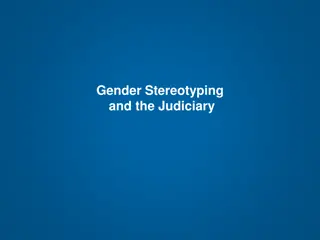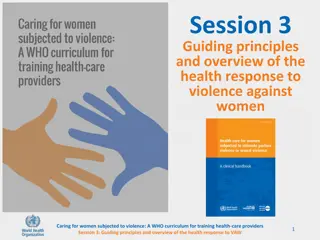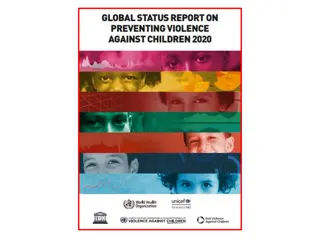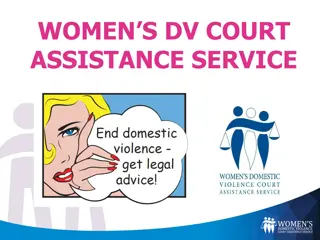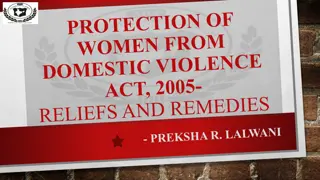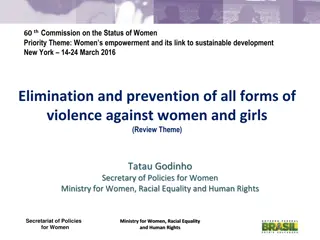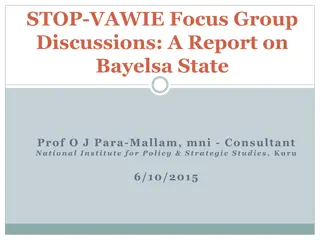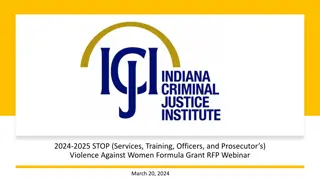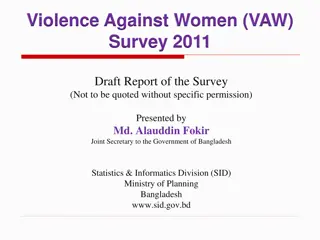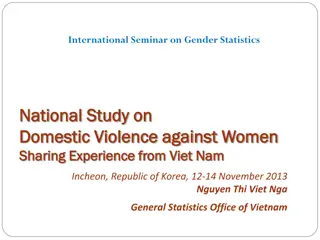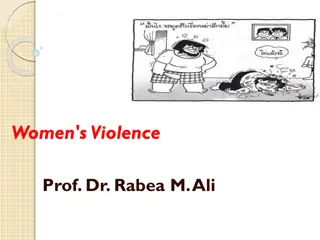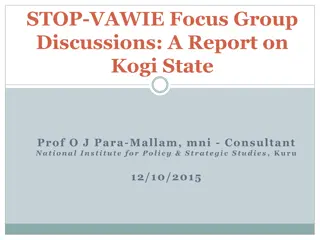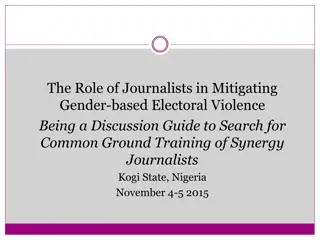Understanding Violence Against Women: A Comprehensive Overview
This presentation delves into the alarming issue of violence against women, covering topics such as the definition of domestic violence, the five forms of abuse (physical, psychological, financial, stalking and harassment, online/digital), gender stereotypes, gender inequality, and sources of support. It highlights the various aspects of abuse women may face, from physical harm to economic control, shedding light on the pervasive nature of these issues and the need for recognition, awareness, and action.
Download Presentation

Please find below an Image/Link to download the presentation.
The content on the website is provided AS IS for your information and personal use only. It may not be sold, licensed, or shared on other websites without obtaining consent from the author. Download presentation by click this link. If you encounter any issues during the download, it is possible that the publisher has removed the file from their server.
E N D
Presentation Transcript
Outline of Presentation What is domestic violence the 5 forms of abuse Gender stereotypes and violence Gender inequality and violence Sources of support
What is domestic violence? The UK Government s definition of domestic violence is: any incident or pattern of incidents of controlling, coercive, threatening behaviour, violence or abuse between those aged 16 or over who are, or have been, intimate partners or family members regardless of gender or sexuality. The abuse can encompass, but is not limited to psychological, physical, sexual, financial, emotional.
The 5 forms of abuse The 5 forms of abuse are: 1. 2. 3. 4. 5. Physical Psychological/emotional Financial/economic Stalking and harassment Online/digital
The 5 forms of abuse: Physical Physical abuse is that involving contact intended to cause fear, pain, injury, other physical suffering or bodily harm. Also includes sexual abuse. Physical and sexual acts which degrade and humiliate women and are perpetrated against their will, including rape.
The 5 forms of abuse: Psychological Also known as emotional abuse. Psychological abuse is when someone is subjected or exposed to a situation that can result in psychological trauma, including anxiety, depression or post- traumatic stress disorder. Psychological abuse can also include coercive control. Coercive control is an act or a pattern of acts of assault, threats, humiliation and intimidation or other abuse that is used to harm, punish, or frighten their victim. This controlling behaviour is designed to make a person dependent by isolating them from support, exploiting them, depriving them of independence and regulating their everyday behaviour.
The 5 forms of abuse: Financial Also known as economic abuse. Financial abuse involves a perpetrator using or misusing money which limits and controlstheir partner s current and future actions and their freedom of choice. It can include using credit cards without permission, putting contractual obligations in their partner s name, and gambling with family assets. Economic abuse is designed to reinforce or create economic instability. In this way it limits women s choices and ability to access safety. Lack of access to economic resources can result in women staying with abusive men for longer and experiencing more harm as a result.
The 5 forms of abuse: Stalking Stalking is a pattern of persistent and unwanted attention that makes you feel pestered, scared, anxious or harassed. Some examples of stalking are: o Regularly giving unwanted gifts o Making unwanted communication o Damaging property o Repeatedly following you or spying on you o Threats Taken in isolation, some of the behaviours may seem like small acts, but together they make up a consistent pattern of behaviour that is frightening and upsetting.
The 5 forms of abuse: Digital Online platforms are increasingly used to perpetrate domestic abuse. Online abuse can include behaviours such as: o Monitoring of social media profiles or emails o Abuse over social media such as Facebook or Twitter o Sharing intimate photos or videos without your consent o Using GPS locators or spyware
Gender Stereotypes & Violence Harmful gender stereotypes, rigid constructions of femininity and masculinity and stereotyped gender roles are a root cause of gender-based violence against women. o Boys: We have boys who cannot express their emotions, become aggressive, under- achieve at school and go on to be part of a culture of toxic masculinity which normalises violence. o Girls: We have girls who have low self-esteem and issues with their body image, as well as self-limiting beliefs of their potential because of their gender. Toxic Masculinity can include: o Shame, disassociation and avoidance of emotional expression. o Extreme self-reliance. o Extreme aspiration for physical, sexual and intellectual dominance. o Devaluation of women s opinions, body and sense of self. o Condemning anything feminine within another man.
Gender Inequality & Violence Gender inequality is both a cause and consequence of violence against women. Violence against women is caused by gender inequality including unequal power relations between women and men, rigid gender roles, norms and hierarchies, and ascribing women lower status in society. Promoting and achieving gender equality is a critical element of the prevention of violence against women.
Clares Law Also known as Domestic Violence Disclosure Scheme, Clare's Law is intended to provide information that could protect someone from being a victim of attack. The scheme allows the police to disclose information on request about a partner's previous history of domestic violence or violent acts. The legislation also allows members of the public to make enquiries into the partner of a close friend or family member. If you have concerns about your partner's background, you can apply for disclosure by going to the police. You can visit your local station in person, call 101 or speak to an officer on the street.
Sources of Support Women s Aid Domestic Abuse Helpline 0808 2000 247 Bilingual Live Fear Free Helpline (Wales) 0808 8010 800 24/7 confidential free phones providing help and advice about violence against women and domestic abuse National LGBT+ Domestic Abuse Helpline 0800 999 5428 Find your local service To find help in your local area, volunteer or donate goods to a local service visit: www.womensaid.org.uk/domestic-abuse-directory


